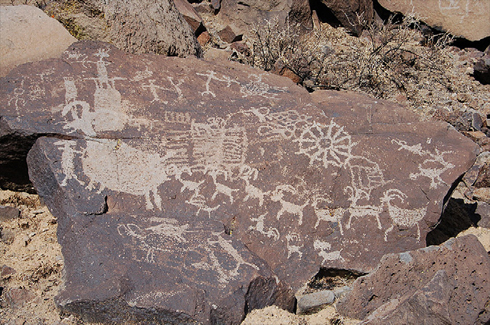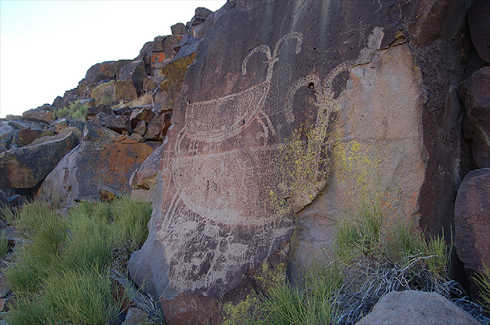Bighorn hunting, resource depression, and rock art in the Coso Range, eastern California: a computer simulation model
Alan P. Garfinkel, David A. Young, Robert M. Yohe II. 2009. Bighorn hunting, resource depression, and rock art in the Coso Range, eastern California: a computer simulation model. Journal of Archaeological Science 37 (2010) 42–51.
Full text [here]
See also: Garfinkel, Alan P. 2007. Paradigm Shifts, Rock Art Studies, and the “Coso Sheep Cult” of Eastern California. North American Archaeologist, Spring 2007. [here]
Selected Excerpts:
Abstract
The extraordinary record of prehistoric rock art depicting tens of thousands of animal images in the Coso Range of eastern California provides an opportunity to study the relationship between aboriginal hunting, forager ecology, bighorn prey population levels, and the production of rock art. We review archaeofaunal evidence that the Coso desert bighorn sheep population was strongly depleted during the Newberry era after 1500 B.C. We discuss the dating of the rock art and show a correlation between bighorn depletion and increased rock art production. These data are consistent with the arrival of Numic foragers ca. A.D. 600 who competed with the Coso Pre-Numics and eventually terminated the Coso rock art tradition. An ecological predator-prey computer simulation of the human populations (Numic and Pre-Numics), the sheep population, and the rock art ‘‘population’’, demonstrates these proposed interconnections and gives a reasonable fit to the observed rock art production rate. …
Introduction
The Coso Range of eastern California has been occupied by humans since the Paleoindian period. The early inhabitants of the area left pecked rock images in very large numbers. Beginning roughly 2000/1500 B.C. and ending about A.D. 1300, aboriginal people left an elaborate record of hunting scenes with bighorn sheep (Ovis canadensis) as their prey. Over time the images become more naturalistic or realistic, larger in size and the image count increases remarkably during its peak period of production and then inexplicably at its peak after about A.D. 1300 the art ceased being produced. There are at least 100,000 individual rock art images represented in the Coso petroglyph record and it is estimated that about half are depictions of bighorn sheep. The Coso Rock Art Complex is one of the largest concentrations of rock drawings in all of North America.
Such a striking array of naturalistic or realistic images is very unusual for the Desert West and this startling record begs explication. Early researchers posited that the tremendous numbers of bighorn representations were indicative of vast herds of bighorn sheep that occupied the area in the distant past. Prehistorians implied that periods of peak sheep hunting correlated with the greatest abundance of bighorn rock art images. Prehistoric animal images were part of a bighorn sheep cult. These images figured in increase rites designed to ensure the return of game animals, human, plant, and animal fecundity, and the health and well-being of the Coso people and their way of life (Garfinkel, 2006; Grant et al., 1968; Hildebrandt and McGuire, 2002; Heizer and Baumhoff,1962).
This paper provides a population estimate for the metapopulation (a group of spatially separated or isolated animals that occupy a fragmented habitat, have limited exchange of individuals, and consist of a number of animal groups that interact in a restricted geographic area) of Coso bighorn and simulates the population dynamic of the local herds in light of human predation. It evaluates the proposition of whether it is possible that bighorn were over-harvested and depleted. Archaeofaunal data are adduced to provide a timeline, trajectory, and independent evaluation of the plausibility for bighorn resource depression. It also posits that the Coso inhabitants were seeing population pressure and conflicting land use issues from the neighboring Numic groups to the north moving into their territory from the Owens Valley. Standard ecological competition and predator-prey models are applied to simulate human and sheep populations. The simulation models sheep hunting across time and also models rock art production.We develop a model of the competing Numic and pre-Numic exploitation and land use strategies and close by providing a partial explanation of why the Coso Range was such an extraordinary focus of rock art expression. …

Fig. 2. Coso Representational rock art, Coso Style sheep, bowmen, and more ancient,
patinated abstract and geometric petroglyph elements.

Fig. 3. Coso Representational rock art, life-sized (7 ft in length from nose to tail)
bighorn sheep in Big Petroglyph Canyon.
Summary and conclusions
In this paper we have examined the archaeological evidence for the dating of Coso rock art, the dating of Coso archaeofaunal remains, and the evidence for an intrusive population that brought the Coso culture to an end. The computer simulation ties these elements together and demonstrates that the explosion of rock art can be explained by assuming that the Coso Prenumic artists increased their activities as the sheep population decreased from over-harvesting.
What might have been the motivation for such a counterproductive behavior pattern? Prestige given to the successful hunter of scarce game might be the answer. As large game hunting increased in importance the depictions altered; bighorn images became more frequent and larger in size. When the bighorn became less plentiful and more difficult to kill a successful hunter would have been provided with greater prestige. Hildebrandt and McGuire (2002:250) point out that the taking and sharing of large game conferred individual fitness benefits for males signaling their authority and achievement. This intensification pattern was a distinctive ‘‘currency’’ correlating with a spike in animal ceremonialism, ritual activity, and the production of symbolic behavior associated with a social system driven by high prestige hunting.
McGuire et al. (2007:363–364) emphasize the important role that prestige hunting plays in local extirpations. They recognize that non-optimal foraging behavior in overkill situations are fueled by the escalating importance of prestige as key prey animals diminish and their consequent rarity heightens the leadership roles of successful hunters and provides greater power and influence mitigating any tendency to prey switch. Significantly, we see this pattern in the rock art record as Coso
hunters are frequently adorned with horned headdresses (n=200).
Hence Coso rock art, in its period of peak production, is not so much a proxy measure of economic abundance and success of bighorn hunts but was, quite the contrary, a manifestation of ritual intensification designed to affect supernatural agents to increase animals, plants, and the availability of water (Garfinkel et al., 2009). The culmination of this tradition is manifested in the life-size depiction of bighorn sheep – a labor intensive effort driven by the desire to appease the deities and revitalize a culture in chaos.
